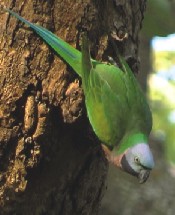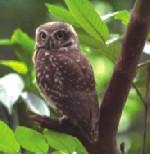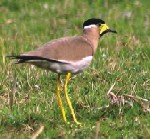Chirp, Twit, warble: Birds Call
Ronald
Halder, a dentist turned nature enthusiast and pioneer bird-watcher,
has come up with a CD that contains delightful songs of the
birds of Bangladesh. His compilation let the public get a taste
of a rare treat.
Mustafa
Zaman
 Spotting
birds and identifying them is a thing only for the bird-watchers,
this idea no longer applies. As all the species of our unique
flora and fauna are seeing a drastic reduction in number, nature
enthusiasts are becoming a major exponent in forming a voice
in favour of conservation. Ronald Halder too thinks that bird-watching
is not merely a hobby, he considers it to be a vehicle that
may lead to an awareness about forest depletion and conservation.
Spotting
birds and identifying them is a thing only for the bird-watchers,
this idea no longer applies. As all the species of our unique
flora and fauna are seeing a drastic reduction in number, nature
enthusiasts are becoming a major exponent in forming a voice
in favour of conservation. Ronald Halder too thinks that bird-watching
is not merely a hobby, he considers it to be a vehicle that
may lead to an awareness about forest depletion and conservation.
A
record of nature is only meaningful when it is done to affect
a change in our attitude towards nature. The album of birdcalls
that Ronald recorded does that and more. It helps identify the
birds of Bangladesh. It took Ronald Halder ten long years to
record the calls of two hundred species of birds.
He
roamed about the land and sifted through its last remaining
forests with his sound appliance in hand: "the thousand
dollar instrument" that traps the sound of nature. Yet
in 10 years he could only furnish a list of 150 calls, as a
lot of the calls still remain to be identified. It is not that
Ronald is at a loss about the origin of these collected chirps,
twits, babbles and warbles, it is just that there are birds
whose three calls are markedly different from one another. He
needs to be sure of the origin of each call before he catalogs
them.
 "I
am still trying to identify birds of whose calls I have already
recorded. As calls are multiple, they can sometimes be misleading,"
says Ronald, who at the insistence of his bird-watching buddy,
Enam Talukdar, mimics the call of the shyma bird. Ronald's sparingly
furnished apartment seems to echo the tasteful proclivities
of its owner, still, In its midst, the birdsong seems unreal.
And the imitator, who almost mimics the call, soon gives up
and declares, "you need a dry mouth for this". He
goes on to explain how each bird has three different calls to
crow about, one, which is the "routine call", the
other that is referred to as "alarm call" and lastly
the one that is the "mating call". As for the shyma,
Ronald has recorded 10 different calls belonging to 10 different
variants of the same species. They were all included in the
CD.
"I
am still trying to identify birds of whose calls I have already
recorded. As calls are multiple, they can sometimes be misleading,"
says Ronald, who at the insistence of his bird-watching buddy,
Enam Talukdar, mimics the call of the shyma bird. Ronald's sparingly
furnished apartment seems to echo the tasteful proclivities
of its owner, still, In its midst, the birdsong seems unreal.
And the imitator, who almost mimics the call, soon gives up
and declares, "you need a dry mouth for this". He
goes on to explain how each bird has three different calls to
crow about, one, which is the "routine call", the
other that is referred to as "alarm call" and lastly
the one that is the "mating call". As for the shyma,
Ronald has recorded 10 different calls belonging to 10 different
variants of the same species. They were all included in the
CD.
There
are many birds that are difficult to spot as they have the habit
of remaining out of sight. The best way to identify them is
through their calls. And Roland Halder has opened up a new vista
by providing a body of knowledge which brings to the forth the
vast reserve of birds in Bangladesh. "I had recorded two
calls of the barbet back in 1998 and could only identify one
call and the other remained a mystery. It was not until 2002
that the mystery was solved," says Ronald, whose passion
for birds paved the way for many other bird and nature enthusiasts.
Ronald is constantly in the lookout for new species, his ears
are eternally cocked up to hear new calls, and the eyes are
always in search of the birds. He progresses by matching the
voice with the owner of the voice. "It is a time consuming
work, but I thoroughly enjoyed my last twelve years," declares
Ronald who believes that there are about 650 species living
in Bangladesh, which he dreads are fast disappearing.
The
CD that was inaugurated on 15 April took two years to edit.
Roland could not leave any room for error or even bad recording.
"Editing is a tedious job", says its maker. "To
aim for the best you need to muster clinical precision,"
adds his fellow enthusiast Enam. The CD is titled "A sound
guide to the Birds of Bangladesh", and is a collection
of 99 calls of birds. Multiple calls of the same bird have been
diligently marked out in the CD.
 "I
thought I was going to put hundred and fifty calls, I worked
towards meeting that goal, but later I found out that one CD
could only provide the space for 99 calls," says Ronald
for whom it is the first step in publication. This album is
the first volume of his collections. More are in the making.
"I
thought I was going to put hundred and fifty calls, I worked
towards meeting that goal, but later I found out that one CD
could only provide the space for 99 calls," says Ronald
for whom it is the first step in publication. This album is
the first volume of his collections. More are in the making.
For
Ronald, 1985 was a decisive year, it was when, as a member of
the British based Oriental Bird Club, he picked up his first
binocular and started the hobby of bird watching. The hobby
soon turned into a serious pursuit. It was not until 1993 that
he ventured into recording of birdsong. "In the first attempt,
I used a common stereo microphone instead of a parabolic one
that suited my purpose. I tied it to a bamboo and the result
certainly was shoddy. But it ignited my passion so much that
I came up with my own version of a parabolic microphone,"
relates Ronald. He contrived a concoction putting an electrode
condenser microphone into a melamine teacup. With this self-generated
equipment he achieved improved recording. It fed on his ambition.
The
first professional parabolic microphone that came his way was
a gift from an American friend Dan Gibson, who is a friend.
"It was a cumbersome equipment that proved to be a very,
very useful tool. Quality recording became possible only after
I received this appliance," says Ronald, who always travels
to forests with companions who share his enthusiasm for nature.
Roland
is known to the string of fellow enthusiasts who became his
close associates and friends over the years as Roni da. And
Ronaldo aka Roni da harks back to his early shenanigans with
his finally acquired thousand dollar light, state of the art
equipment in hand. He remembers how in the late nineties he
and his peers used to wander through the woods to record the
hoots of owls.
"We
used to plan ahead to make it convenient for all who tagged
along, every trip had to be a well coordinated one, it still
is," says Enam, who accompanied Ronald in many occasions.
Ronald remembers how he and his companions used to trudge the
forest in search of owls. "In 1998 we went to Modhupur
forest where I recorded owls' calls that features in the CD,"
says Ronald. "Calls plays a significant part in our country
life and even our folklore. I remember how my nani (grandmother)
used to ask to cook for guests who might turn up after hearing
the athith (guest) bird sing, which was taken as an announcement
for the arrival of guests," Ronald adds.
 Ronald
grew up in Faridpur, where his grandfather worked in the missionary
school. He remembers the swamp forest that used to hide in it
the ample reserve of birds that made the child Ronald curious
about nature. "It started at an early age, the forests
and vegetation made all the difference. We grew up in proximity
with nature," says Ronald.
Ronald
grew up in Faridpur, where his grandfather worked in the missionary
school. He remembers the swamp forest that used to hide in it
the ample reserve of birds that made the child Ronald curious
about nature. "It started at an early age, the forests
and vegetation made all the difference. We grew up in proximity
with nature," says Ronald.
The
forest of his home district disappeared long ago, along with
it the bird population. Habitat loss is the main reason. Ronald's
concern for loss of species, of which little is known to the
somewhat eco-ignorant urban Bangladeshis, a genuine one. He
wants to break the slumber. While many are simply oblivious
to the effect of losing the natural diversity Ronald's endeavour
is an alarm call of his own composition.
As
a photographer Ronald has recorded the treasures that are categorically
being effaced from the face of the earth, and he is not sitting
on his success in working with birds only. His documentary in
the year 2000 on the Shatchory forest bordering the southern
part of Sylhet is a sad testimony of how the forest is disappearing
as humans are transgressing the domain of animals and birds.
"The
forestation programme that the forest department has taken up
is a farce, as birds and animals need natural forest to make
their home. Even a bird like the woodpecker can only turn a
thirty year old tree into its nest," Enam testifies. The
old and the natural forest is the only home of the dwindling
bird and animal population of Bangladesh, this is a fact that
the government is taking years to wake up to. Ronald also did
a documentary on the Tangua Haor in Shunamganj. This helped
shape a voice that made the government to take up some measures.
The
CD of Ronald is not just a compilation to savour what he himself
refers to as "exquisite musical compositions of nature".
It serves to soothe the ears, which is plus in itself. But it
is also a wake up call for many who never really thought that
human aggression has such potential to usher in a natural calamity
that results from deforestation.
Photo
by Roland Halder

 Spotting
birds and identifying them is a thing only for the bird-watchers,
this idea no longer applies. As all the species of our unique
flora and fauna are seeing a drastic reduction in number, nature
enthusiasts are becoming a major exponent in forming a voice
in favour of conservation. Ronald Halder too thinks that bird-watching
is not merely a hobby, he considers it to be a vehicle that
may lead to an awareness about forest depletion and conservation.
Spotting
birds and identifying them is a thing only for the bird-watchers,
this idea no longer applies. As all the species of our unique
flora and fauna are seeing a drastic reduction in number, nature
enthusiasts are becoming a major exponent in forming a voice
in favour of conservation. Ronald Halder too thinks that bird-watching
is not merely a hobby, he considers it to be a vehicle that
may lead to an awareness about forest depletion and conservation.
 "I
am still trying to identify birds of whose calls I have already
recorded. As calls are multiple, they can sometimes be misleading,"
says Ronald, who at the insistence of his bird-watching buddy,
Enam Talukdar, mimics the call of the shyma bird. Ronald's sparingly
furnished apartment seems to echo the tasteful proclivities
of its owner, still, In its midst, the birdsong seems unreal.
And the imitator, who almost mimics the call, soon gives up
and declares, "you need a dry mouth for this". He
goes on to explain how each bird has three different calls to
crow about, one, which is the "routine call", the
other that is referred to as "alarm call" and lastly
the one that is the "mating call". As for the shyma,
Ronald has recorded 10 different calls belonging to 10 different
variants of the same species. They were all included in the
CD.
"I
am still trying to identify birds of whose calls I have already
recorded. As calls are multiple, they can sometimes be misleading,"
says Ronald, who at the insistence of his bird-watching buddy,
Enam Talukdar, mimics the call of the shyma bird. Ronald's sparingly
furnished apartment seems to echo the tasteful proclivities
of its owner, still, In its midst, the birdsong seems unreal.
And the imitator, who almost mimics the call, soon gives up
and declares, "you need a dry mouth for this". He
goes on to explain how each bird has three different calls to
crow about, one, which is the "routine call", the
other that is referred to as "alarm call" and lastly
the one that is the "mating call". As for the shyma,
Ronald has recorded 10 different calls belonging to 10 different
variants of the same species. They were all included in the
CD.  "I
thought I was going to put hundred and fifty calls, I worked
towards meeting that goal, but later I found out that one CD
could only provide the space for 99 calls," says Ronald
for whom it is the first step in publication. This album is
the first volume of his collections. More are in the making.
"I
thought I was going to put hundred and fifty calls, I worked
towards meeting that goal, but later I found out that one CD
could only provide the space for 99 calls," says Ronald
for whom it is the first step in publication. This album is
the first volume of his collections. More are in the making.
 Ronald
grew up in Faridpur, where his grandfather worked in the missionary
school. He remembers the swamp forest that used to hide in it
the ample reserve of birds that made the child Ronald curious
about nature. "It started at an early age, the forests
and vegetation made all the difference. We grew up in proximity
with nature," says Ronald.
Ronald
grew up in Faridpur, where his grandfather worked in the missionary
school. He remembers the swamp forest that used to hide in it
the ample reserve of birds that made the child Ronald curious
about nature. "It started at an early age, the forests
and vegetation made all the difference. We grew up in proximity
with nature," says Ronald.